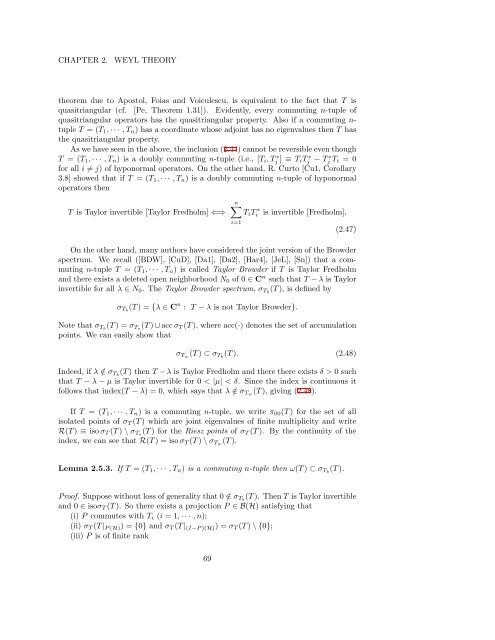Woo Young Lee Lecture Notes on Operator Theory
Woo Young Lee Lecture Notes on Operator Theory
Woo Young Lee Lecture Notes on Operator Theory
Create successful ePaper yourself
Turn your PDF publications into a flip-book with our unique Google optimized e-Paper software.
CHAPTER 2.<br />
WEYL THEORY<br />
theorem due to Apostol, Foias and Voiculescu, is equivalent to the fact that T is<br />
quasitriangular (cf. [Pe, Theorem 1.31]). Evidently, every commuting n-tuple of<br />
quasitriangular operators has the quasitriangular property. Also if a commuting n-<br />
tuple T = (T 1 , · · · , T n ) has a coordinate whose adjoint has no eigenvalues then T has<br />
the quasitriangular property.<br />
As we have seen in the above, the inclusi<strong>on</strong> (2.44) cannot be reversible even though<br />
T = (T 1 , · · · , T n ) is a doubly commuting n-tuple (i.e., [T i , T ∗ j ] ≡ T iT ∗ j − T ∗ j T i = 0<br />
for all i ≠ j) of hyp<strong>on</strong>ormal operators. On the other hand, R. Curto [Cu1, Corollary<br />
3.8] showed that if T = (T 1 , · · · , T n ) is a doubly commuting n-tuple of hyp<strong>on</strong>ormal<br />
operators then<br />
T is Taylor invertible [Taylor Fredholm] ⇐⇒<br />
n∑<br />
T i Ti<br />
∗<br />
i=1<br />
is invertible [Fredholm].<br />
(2.47)<br />
On the other hand, many authors have c<strong>on</strong>sidered the joint versi<strong>on</strong> of the Browder<br />
spectrum. We recall ([BDW], [CuD], [Da1], [Da2], [Har4], [JeL], [Sn]) that a commuting<br />
n-tuple T = (T 1 , · · · , T n ) is called Taylor Browder if T is Taylor Fredholm<br />
and there exists a deleted open neighborhood N 0 of 0 ∈ C n such that T − λ is Taylor<br />
invertible for all λ ∈ N 0 . The Taylor Browder spectrum, σ Tb (T ), is defined by<br />
σ Tb (T ) = {λ ∈ C n : T − λ is not Taylor Browder}.<br />
Note that σ Tb (T ) = σ Te (T ) ∪ acc σ T (T ), where acc(·) denotes the set of accumulati<strong>on</strong><br />
points. We can easily show that<br />
σ Tw (T ) ⊂ σ Tb (T ). (2.48)<br />
Indeed, if λ /∈ σ Tb (T ) then T − λ is Taylor Fredholm and there there exists δ > 0 such<br />
that T − λ − µ is Taylor invertible for 0 < |µ| < δ. Since the index is c<strong>on</strong>tinuous it<br />
follows that index(T − λ) = 0, which says that λ /∈ σ Tw (T ), giving (2.48).<br />
If T = (T 1 , · · · , T n ) is a commuting n-tuple, we write π 00 (T ) for the set of all<br />
isolated points of σ T (T ) which are joint eigenvalues of finite multiplicity and write<br />
R(T ) ≡ iso σ T (T ) \ σ Te (T ) for the Riesz points of σ T (T ). By the c<strong>on</strong>tinuity of the<br />
index, we can see that R(T ) = iso σ T (T ) \ σ Tw (T ).<br />
Lemma 2.5.3. If T = (T 1 , · · · , T n ) is a commuting n-tuple then ω(T ) ⊂ σ Tb (T ).<br />
Proof. Suppose without loss of generality that 0 /∈ σ Tb (T ). Then T is Taylor invertible<br />
and 0 ∈ isoσ T (T ). So there exists a projecti<strong>on</strong> P ∈ B(H) satisfying that<br />
(i) P commutes with T i (i = 1, · · · , n);<br />
(ii) σ T (T | P (H) ) = {0} and σ T (T | (I−P )(H) ) = σ T (T ) \ {0};<br />
(iii) P is of finite rank<br />
69













